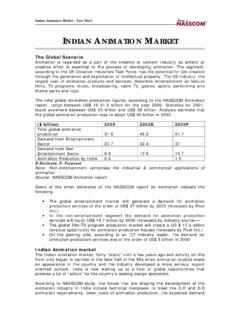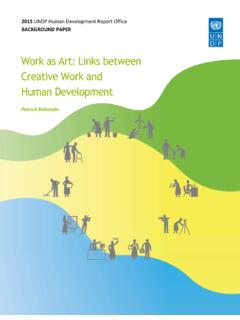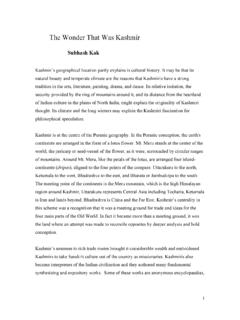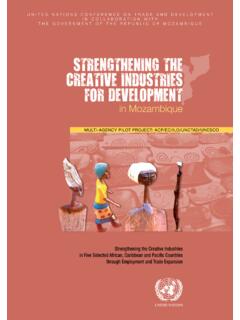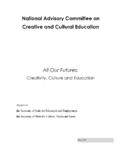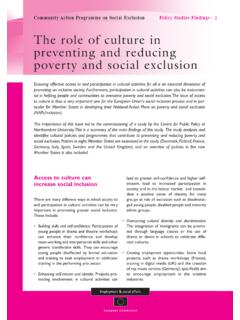Transcription of Valuing the Art of Industrial Design
1 National Endowment for the ArtsValuing the Art of Industrial DesignA Profile of the Sector and Its Importance to Manufacturing, Technology, and InnovationBonnie Nichols NEA Office of Research & AnalysisFront cover photos courtesy of Smithsonian Cooper-Hewitt, National Design Museum, from its permanent collectionA flared white basket in a loose cross-hatched pattern, glazed earthenware, circa Compass laptop computer prototype, designed by Bill Moggridge, chair, designed by Vladimir Kagan, Streak iron, model 1038, designed by Corning Glass Works, 1942 Endowment for the arts Research Report #56 Valuing the Art of Industrial DesignA Profile of the Sector and Its Importance to Manufacturing, Technology, and InnovationBonnie Nichols NEA Office of Research & AnalysisAugust 2013 Research Report #56 August 2013 National Endowment for the arts 1100 Pennsylvania Avenue, Washington, 20506 Telephone: by the Office of Research & AnalysisSunil Iyengar, DirectorBonnie Nichols, Research AnalystOther staff contributors: Steven Shewfelt, Tamika Shingler, Melissa Menzer, and Ellen GranthamEditorial assistance by Don BallDesigned by Roman/Thayer Design Inc.
2 For their valuable assistance while this report was in production, the NEA Office of Research & Analysis would like to thank the following people: Mariana Amatullo (Art Center College of Design ); Mike Gallagher (Crown Equipment Corporation); Jim Hirabayashi ( Patent & Trademark Office); Daniel Martinage ( Industrial Designers Society of America); Emma Presler (Museum of Modern Art); Beth Siegel (Mt. Auburn Associates); and Harry West and Kevin Young (Continuum).Library of Congress Cataloging-in-Publication DataNichols, Bonnie. Valuing the art of Industrial Design : a profile of the sector and its importance to manufacturing, technology, and innovation / Bonnie Nichols. pages cm.
3 -- (Research report ; #56) June 2013. Includes bibliographical references. 1. Industrial designers--Salaries, States--Statistics. 2. Industrial Design --Economic aspects--United States--Statistics. I. National Endowment for the arts . II. Title. 2013 2013028449202-682-5496 Voice/TTY (a device for individuals who are deaf or hearing-impaired)Individuals who do not use conventional print materials may contact the arts Endowment s Office for AccessAbility at 202-682-5532 to obtain this publication in an alternate publication is available free of charge in print or PDF format at , the website of the National Endowment for the of Contents 4 Preface 7 Introduction 8 Executive Summary 12 Part 1.
4 Industrial Design as an Occupation 24 Part 2. Industrial Design as a Business 36 Part 3. Industrial Design as a Product Innovator 46 Conclusion: The NEA and Industrial Design 48 Appendix 49 References4 | PrefacePrefaceDesign is a field with a large and extensive presence in our nation s manufacturing and services industries, as documented by the national datasets that provide the basis for this report. Designers are prolifically inventing new products, processes, and systems that have a profound impact on our economy and civil society. The National Endowment for the arts (NEA) Design Program has been tracking numerous trends in the field of Design , from the growing movement of Design thinking to social impact Design .
5 Although this report brings together, for the first time, analytical perspectives regarding federal data on Industrial Design , it cannot be all-encompassing. This preface has benefited from conversations with some of the nation s leading designers, Design curators, and Design firms to convey information not captured by the report itself. An Expanding Definition for Industrial Design Much of the data in this report are drawn from the Bureau of Labor Statistics (BLS). The Occupational Handbook Outlook from the BLS defines Industrial designers as those individuals that develop the concepts for manufactured products such as cars, home appliances, and toys. While this dataset enables a quantitative grasp of the industry, BLS definition is arguably limited in scope.
6 Today s Industrial designers find themselves in a variety of roles and functions beyond the development of manufactured products. Industrial designers are working on projects for a variety of organizations, from government entities to private enterprises. Using a creative lens for approaching complex problems or challenges (often referred to as the Design process), designers are engaged by a range of clients to bring a fresh approach to age-old issues. Industrial designers are not just designing commercial products, but designing user experiences, processes, and systems by applying the creative approach of what has been come to be known as Design thinking. The idea to utilize the Design process as a way to analyze and innovate has been widely embraced from business schools to major consulting practices and has changed the landscape of how Industrial designers work.
7 For example, an Industrial designer might not only Design a high-tech medical device for a hospital, but also the patient s interactive experience and touch points with medical staff in the emergency room. Similarly, Industrial designers might work with retail merchandisers to reorganize store floor plans and re-imagine the in-store experience for potential customers. Design thinking requires Industrial designers to work on diverse teams to solve these more complex challenges. In a typical firm, a team might include an engineer, Design strategist, marketer, and anthropologist, as well as software designers and developers, as products become more intelligent and responsive to media the Art of Industrial Design | 5 Historically, Industrial Design has been a field of invention driven by market demand or clients.
8 Today, there are many examples of designers pursuing clientless endeavors; some have even been on display at the Museum of Modern Art in New York. These artists probably would self-identify as Industrial designers; their contributions to developing clientless work as an art form is an acknowledged practice, but one not quantifiable from the datasets explored in this report. Furthermore, Industrial designers are applying their skills to projects that achieve a broader social impact, for populations that cannot afford to hire a designer For example, Design that Matters is a 501(c)(3) nonprofit that creates new products that allow social enterprises in developing countries to offer improved services and scale more quickly.
9 2 Design that Matters works with Industrial designers, manufacturers, and other nongovernmental organizations to develop scalable products that serve low-resource communities around the globe. Winner of the 2012 National Design Award for Corporate & Institutional Achievement, Design that Matters is developing product innovations within the nonprofit sector for significant impact. One such innovation is an affordable phototherapy device to treat jaundiced newborns in South Asian and Sub-Saharan Africa. Postsecondary educational programs are retooling their curricula to reflect these more fluid approaches to Industrial Design . Bachelor s and master s programs in Industrial Design reflect the interdisciplinary nature of Industrial Design work.
10 Course curriculums at leading Design institutions include anthropology, systems Design , and entrepreneurship in addition to the traditional manufacturing and Design studio course requirements. Universities are also developing hybrid programs that apply Design thinking to business and other fields of practice. Professionals trained in these postsecondary programs might find themselves working for a company where their creative skills are engaged and applied to client-driven work or systems improvement. The cross-disciplinary training and expanded professional role of Industrial Design thus make it difficult to assess the field conclusively by examining federal datasets alone.











